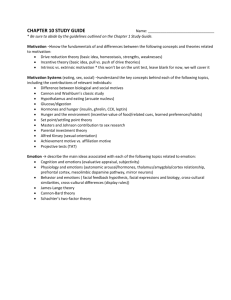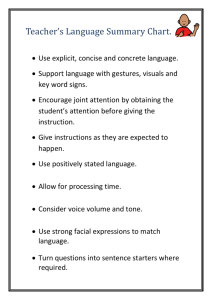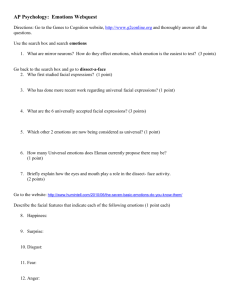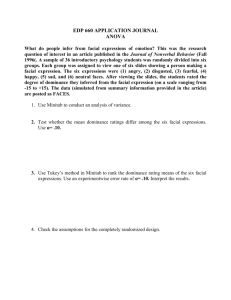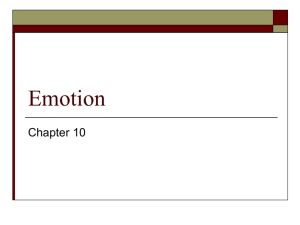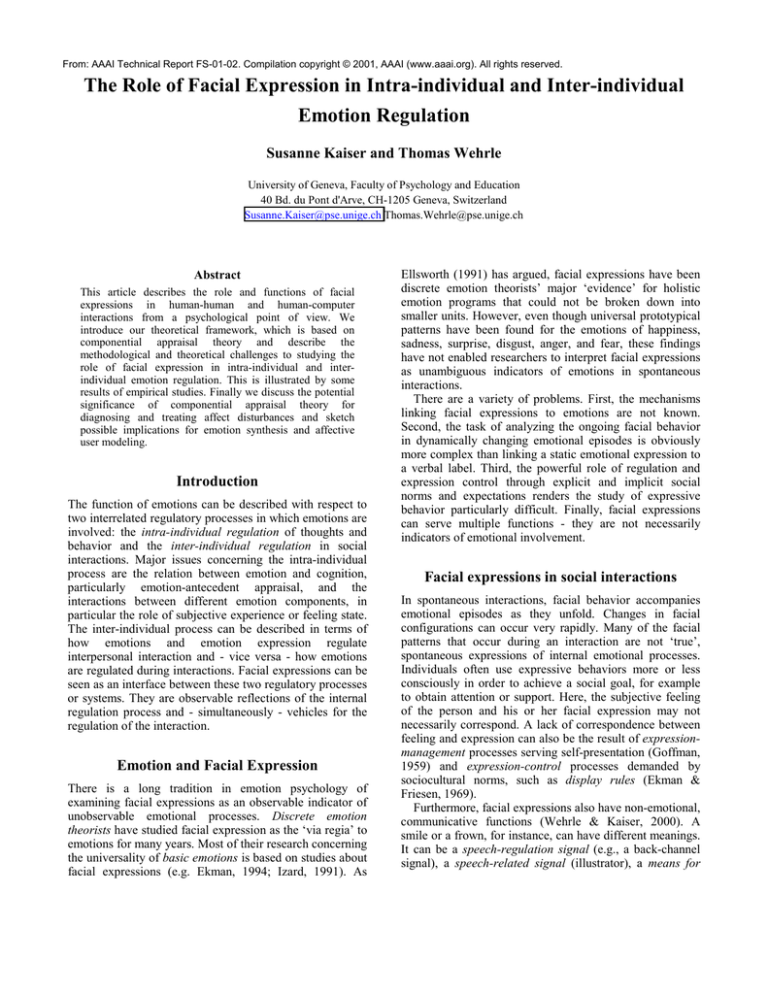
From: AAAI Technical Report FS-01-02. Compilation copyright © 2001, AAAI (www.aaai.org). All rights reserved.
The Role of Facial Expression in Intra-individual and Inter-individual
Emotion Regulation
Susanne Kaiser and Thomas Wehrle
University of Geneva, Faculty of Psychology and Education
40 Bd. du Pont d'Arve, CH-1205 Geneva, Switzerland
Susanne.Kaiser@pse.unige.ch Thomas.Wehrle@pse.unige.ch
Abstract
This article describes the role and functions of facial
expressions in human-human and human-computer
interactions from a psychological point of view. We
introduce our theoretical framework, which is based on
componential appraisal theory and describe the
methodological and theoretical challenges to studying the
role of facial expression in intra-individual and interindividual emotion regulation. This is illustrated by some
results of empirical studies. Finally we discuss the potential
significance of componential appraisal theory for
diagnosing and treating affect disturbances and sketch
possible implications for emotion synthesis and affective
user modeling.
Introduction
The function of emotions can be described with respect to
two interrelated regulatory processes in which emotions are
involved: the intra-individual regulation of thoughts and
behavior and the inter-individual regulation in social
interactions. Major issues concerning the intra-individual
process are the relation between emotion and cognition,
particularly emotion-antecedent appraisal, and the
interactions between different emotion components, in
particular the role of subjective experience or feeling state.
The inter-individual process can be described in terms of
how emotions and emotion expression regulate
interpersonal interaction and - vice versa - how emotions
are regulated during interactions. Facial expressions can be
seen as an interface between these two regulatory processes
or systems. They are observable reflections of the internal
regulation process and - simultaneously - vehicles for the
regulation of the interaction.
Emotion and Facial Expression
There is a long tradition in emotion psychology of
examining facial expressions as an observable indicator of
unobservable emotional processes. Discrete emotion
theorists have studied facial expression as the ‘via regia’ to
emotions for many years. Most of their research concerning
the universality of basic emotions is based on studies about
facial expressions (e.g. Ekman, 1994; Izard, 1991). As
Ellsworth (1991) has argued, facial expressions have been
discrete emotion theorists’ major ‘evidence’ for holistic
emotion programs that could not be broken down into
smaller units. However, even though universal prototypical
patterns have been found for the emotions of happiness,
sadness, surprise, disgust, anger, and fear, these findings
have not enabled researchers to interpret facial expressions
as unambiguous indicators of emotions in spontaneous
interactions.
There are a variety of problems. First, the mechanisms
linking facial expressions to emotions are not known.
Second, the task of analyzing the ongoing facial behavior
in dynamically changing emotional episodes is obviously
more complex than linking a static emotional expression to
a verbal label. Third, the powerful role of regulation and
expression control through explicit and implicit social
norms and expectations renders the study of expressive
behavior particularly difficult. Finally, facial expressions
can serve multiple functions - they are not necessarily
indicators of emotional involvement.
Facial expressions in social interactions
In spontaneous interactions, facial behavior accompanies
emotional episodes as they unfold. Changes in facial
configurations can occur very rapidly. Many of the facial
patterns that occur during an interaction are not ‘true’,
spontaneous expressions of internal emotional processes.
Individuals often use expressive behaviors more or less
consciously in order to achieve a social goal, for example
to obtain attention or support. Here, the subjective feeling
of the person and his or her facial expression may not
necessarily correspond. A lack of correspondence between
feeling and expression can also be the result of expressionmanagement processes serving self-presentation (Goffman,
1959) and expression-control processes demanded by
sociocultural norms, such as display rules (Ekman &
Friesen, 1969).
Furthermore, facial expressions also have non-emotional,
communicative functions (Wehrle & Kaiser, 2000). A
smile or a frown, for instance, can have different meanings.
It can be a speech-regulation signal (e.g., a back-channel
signal), a speech-related signal (illustrator), a means for
signaling relationship (e.g., when a couple is discussing a
controversial topic, a smile can indicate that although they
disagree on the topic there is no "danger" for the
relationship), an indicator for cognitive processes (e.g.,
frowning while concentratedly attending to a problem, or
when a difficulty is encountered in a task), or an indicator
for an emotion (affect display). Affect displays that occur
during an interaction can refer to the interaction partner
(e.g., becoming angry with the other) but it can also refer to
other persons or themes the interaction partners are talking
about (e.g., sharing the anger about something).
Given and the multi-functionality of facial behavior and
the swiftness of expression changes, research paradigms for
studying emotions and facial expressions should fulfill the
following requirements:
• Approaches to measure facial expressions objectively
and on a micro-analytic level are indispensable.
Anatomically based coding systems like the Facial
Action Coding System (FACS; Ekman & Friesen, 1978)
lend themselves to this purpose. Only if coding is
independent of prior assumptions about prototypical
emotion expressions we can test and compare different
hypotheses about linking facial expression to emotions.
• The concrete meaning of a facial expression can only be
determined within the whole temporal and situational
context. In everyday interactions, we know the context
and we can use all information that is available to
interpret the facial expression of another person.
Therefore, facial expressions and emotions should be
studied in an interactive context.
Appraisal and Facial Expression
Most studies on facial expression of emotions have been
conducted by researchers within the tradition of discrete
emotion theories (e.g., Ekman, 1994; Izard, 1991). These
theories claim that there is only a limited number of socalled fundamental or “basic emotions” and that for each of
them there exists a prototypical, innate, and universal
expression pattern. In this tradition, a process of mixing or
blending of the basic expression patterns explains the
variability of the observable emotion expression patterns.
Compared to this rather molar approach, componential
appraisal theory (for details see Wehrle, Kaiser, Schmidt,
& Scherer, 2000) is more molecular, focusing on individual
muscles and their functions. Componential appraisal theory
assumes that the specific pattern of facial muscle
movements, which characterizes the expression of a
particular emotional state, is the result of emotionantecedent cognitive appraisal and associated action
tendencies (Frijda & Tcherkassof, 1997; Kaiser & Wehrle,
2001; Smith & Scott, 1997). In line with this reasoning,
facial expressions are analyzed as indicators of appraisal
processes in addition to or as an alternative to verbal
reports and other measures. Facial expressions are not seen
as the “readout” of motor programs but as indicators of
mental states and evaluation processes.
This interest in facial expressions is linked to the idea
that emotion-antecedent information processing can occur
at different levels, as suggested by Leventhal and Scherer
(1987). The hope is that appraisal processes occurring on
the sensory-motor or schematic level that are not or only
with great difficulty accessible through verbalization might
be accessible via facial expressions. Another reason for
analyzing facial expressions in experimental emotion
research is that they are naturally accompanying an
emotional episode, whereas asking subjects about their
feelings interrupts and changes the process.
For instance, there is a general consensus that raising the
eyebrows and raising the upper eyelids are associated with
appraisal dimensions related to attentional activity, novelty,
and unexpectedness. The strongest consensus concerns the
postulate that corrugator activity (frown) not only encodes
unpleasantness but more specifically perceived goal
obstacles and the presence of goal discrepancies (Smith &
Scott, 1997).
In our view, the attempts of linking facial actions to
appraisal dimensions are not only of theoretical interest;
they become crucial as soon as we go beyond the question
of the universality of emotional expressions and aiming at
studying spontaneous facial expressions in social
interactions. We do not deny the existence of distinct facial
signals that can be reliably recognized across cultures as
expressing the emotions of happiness, sadness, surprise,
disgust, anger, and fear. However, the evidence for this has
relied almost exclusively on judgment studies using slides
of carefully selected expressions. Since such prototypical
full-face expression patterns occur rather rarely in daily
interactions, the question of whether and how single facial
actions and partial combinations can be interpreted
becomes crucial.
In the preceding sections, we have illustrated some of the
methodological and theoretical problems we are confronted
with if we want to study the process of emotional
interactions and its reflection in facial activity in interactive
settings. To tackle some of these problems we are using a
theoretical and experimental framework including
computerized data collection and data analysis instruments
on the one hand, and computer simulation and theory based
synthetic stimuli on the other hand.
Testing Theoretical Predictions with Synthesized
Facial Expressions
The Facial Animation Composing Environment (FACE;
Wehrle, 1995/1999) is an animation instrument that allows
researchers to systematically vary different aspects of the
dynamics of facial expressions and to control or manipulate
other perceptual cues, such as accompanying head
movements, head position, gaze direction, or even the
physiognomy of a person, all of which might affect emotion
inferences. With FACE we can create three-dimensional
animated facial expressions in real time. The contours of
the face are represented with splines, as are the prominent
features of the face such as eyebrows and lips. The
repertoire of facial expressions for the animation was
defined on the basis of FACS. The FACS coding manual
gives a detailed description of all the appearance changes
occurring with a given Action Unit. This description lists
the parts of the face that have moved and the direction of
their movements, the wrinkles that have appeared or have
deepened, and the alterations in the shape of the facial
parts. Action Units can be produced asymmetrically and at
different levels of intensity (following the five intensity
levels of FACS). In addition, FACE allows the user to vary
the intensity and time profiles of facial movements in terms
of attack (onset), sustain (apex), and release (offset)
duration.
Using FACE in a judgment study, Wehrle et al. (2000)
have extended and refined Scherer’s original predictions
linking facial actions to the postulated appraisal checks
(Scherer, 1992). Scherer posits relatively few basic criteria
and assumes sequential processing of these criteria in the
appraisal process. The major "stimulus evaluation checks"
(SECs) can be categorized into five major classes: 1) the
novelty or familiarity of an event, 2) the intrinsic
pleasantness of objects or events, 3) the significance of the
event for the individual’s needs or goals, 4) the individual’s
ability to influence or cope with the consequences of the
event, including the evaluation of who caused the event
(agency), and 5) the compatibility of the event with social
or personal standards, norms, or values (for details see
Wehrle et al., 2000; Kaiser & Wehrle, 2001).
Figure 1. Predictions for the appraisal patterns and the related
facial actions for elation and sensory pleasure as published in
Wehrle et al. (2000).
Interesting results have been found concerning the
differentiation of positive emotions for which discrete
emotion theorists and appraisal theorists make different
predictions. Proponents of discrete emotion theory argue
that positive emotions such as amusement, contentment,
excitement, pride in achievement, satisfaction, sensory
pleasure, and relief, all share a particular type of smile (i.e.,
a Duchenne smile, which is defined as the Action Unit
combination of AU12 (lip raiser) and AU6 (orbicularis
occuli) producing crows-feet wrinkles at the eye corners)
and that no further facial signal will be found that
differentiates among these positive emotions (Ekman,
1994). Following an appraisal-based approach, Wehrle et
al. postulate that these different positive emotions do
produce different facial patterns, since the respective
underlying appraisal profiles are not identical. The results
show that judges differentiated well between sensory
pleasure, happiness, elation, and - to a lesser degree - pride
(the predicted facial expressions for elation and sensory
pleasure are shown in Figure 1).
Appraisal and Facial Expressions in HumanComputer Interactions
In the following, we present some results from our
experimental research, using human-computer interactions
for studying the dynamics and the interactive nature of
emotional episodes. For this purpose, we developed the
Geneva Appraisal Manipulation Environment (GAME;
Wehrle 1996), a tool for generating experimental computer
games that translate psychological theories into specific
micro-world scenarios (labyrinths with objects and
enemies; more details are published in Kaiser & Wehrle,
1996, 2001; Kaiser, Wehrle, & Schmidt, 1998; Wehrle &
Kaiser, 2000). GAME allows automatic data recording and
automatic questionnaires. While playing the experimental
game, subjects are videotaped and these tape recordings
allow an automatic analysis of the subject’s facial behavior
with the Facial Expression Analysis Tool (FEAT; Kaiser &
Wehrle, 1992; Wehrle, 1992/1996). With FEAT, facial
actions are categorized in terms of FACS. These facial data
can be automatically matched to the corresponding game
data (using the vertical time code as a reference for both
kinds of data). In this way, the computer game provides a
relatively small but complete context for the interpretation
of the internal emotional and cognitive regulatory
processes. This is an important point, because what is felt
by the subject and what a certain facial expression means is
often very context specific.
The behavior of the "virtual" interaction partners in the
game is to a large degree determined by the experimenter
when defining the experimental game parameters. This
approach allows the researcher to create theory based
scenarios for specific emotions and to confront all subjects
with the same events. However, those events are embedded
within a larger context of not completely determined
individual paths, since the subjects' behavior and their
decisions do influence and change the constellation of the
ongoing game to a certain degree. Since all the information
necessary to reconstruct the complete situational context is
registered, we can follow each individual path. Thus, we
can analyze more systematically the sources for differences
in individual reactions to a specific event in terms of
behavior (attack versus avoidance), appraisal (pleasant
versus unpleasant, conducive versus obstruct), and reported
feeling (joy, worry, etc).
The results show that the theoretically designed emotion
eliciting situations actually led to different empirical
appraisal profiles. Also, the participants’ subjective
appraisals matched closely the objective characteristics of
the game situations. Detailed analyses of the subjective
appraisal profiles allow us to systematically determine why
some subjects report other emotions than the theoretically
predicted target emotion, which has been reported by the
majority of the participants. For example, when analyzing
an increased-speed game episode, we found that 73% of
the subjects reported relief or happiness when AMIGO (an
animated agent in the game, which is generally supporting
and helping the player) reduced speed again. However,
27% of the subjects reported anger or disappointment. The
analysis of the appraisal profiles showed that those subjects
who reacted with a negative emotion to the reduction had
evaluated the increased speed as being pleasant (versus
unpleasant) and as being less relevant for their goals than
subjects that reacted with relief. Furthermore, the automatic
data protocol allowed us to predict subjects' emotional
reaction on the basis of how successfully they coped with
the high-speed episode.
Other interesting results concern role of expression
control and the role of smiles in this context. Although the
interaction is only indirectly social, we find many smiles
and smile controls (e.g., asymmetric smiles or smiles that
occur with signs of negative emotions; see Keltner, 1995),
similar to those found in human-human interactions.
Individual differences and affect disturbances
An important advantage of an appraisal-based approach is
that it allows studying individual appraisal tendencies and
action preferences (coping styles) that become evident over
different situations and which can be seen as indicators of a
more or less stable personal style. For example, some
subjects tend to make internal causal attributions (agency
self) even in situations that are objectively not controllable.
Furthermore, we can differentiate the participants’ coping
strategies according to their rigidity versus flexibility, their
impulsivity versus reflexivity, their complexity, and their
situational adaptivness. Therefore, one might envisage
using the experimental environment for diagnostic
purposes.
Kaiser and Scherer (1998) have argued the utility of
applying models of normal emotions to a variety of affect
disturbances and maladaptive stress responses. Affective
disorders can be conceptualized as malfunctions of intraindividual and inter-individual regulation. The former
involves inadequate appraisal of situations and events as
well as dissociation of the relationships between the
different emotion components; the latter comprises
inappropriate expression of affect and major deficiencies in
the interpersonal adjustment of affect in social interaction.
Kaiser and Scherer have formulated concrete predictions
concerning disorder specific appraisal biases and
deviations from normal emotions including specific facial
expression deviations, which can be used to study the
underlying – mostly unconscious – processes. Generally,
this approach allows us to generate a large number of
theoretical predictions that are concrete and testable and
that can solidly be based on empirical work. With FACE,
we can animate the postulated expression patterns and test
their validity in judgment studies asking therapists to
decode the expressions in terms of clinical syndromes and
appraisal biases (see Figure 2 for some examples of the
postulated expressions, synthesized with FACE).
Figure 2. An example of a controlled or masking smile as found
in the experimental study (see Kaiser & Wehrle, 2001) and
synthesized with FACE.
We are convinced that the regulative function of smiles
is not limited to the interactive regulation level but also
concerns the intra-psychic regulation (as an intra-psychic
coping strategy for handling negative affects). In the
experimental game we can differentiate between negative
situations that subjects hold themselves responsible for
(self-caused) and negative situations that subjects perceive
as caused by an agent in the game (other-caused). In line
with our hypothesis we find significantly more controlled
smiles in self-caused negative situations as compared to
other-caused negative situations. Figure 2 shows an
example of such a controlled smile in reaction to a player's
own mistake. Furthermore, the results indicate that
generally interpreting the occurrence of a smile as an
indicator of happiness might be misleading.
Figure 3. Predictions for the appraisal biases and the related
facial actions for helplessness, hopelessness and anxiety disorder
as published in Kaiser & Scherer (1998).
Potential implications for clinical research
and treatment
Roseman and Kaiser (2001) have pointed to another
potential advantage of componential appraisal theory in
diagnostic and therapeutic work. The multi-level approach
of componential appraisal theories can help to describe the
cognitions underlying both the source and surface affects in
dynamically interrelated emotion states, and precisely
describe the cognitive reinterpretations involved in
alternative emotion-regulation strategies or defense
mechanisms.
Multi-level
stimulus
processing is
increasingly used in discussions of cognition and emotion
interaction, especially in the context of memory and affect
disturbance (e.g. Johnson, 1994; Power & Dalgleish, 1997;
Teasdale & Barnard, 1993). Multi-level approaches may
provide an explanation for how simultaneous or conflicting
emotions (with different degrees of awareness) could
occur. They may also explain why knowledge and feeling
can sometimes be dissociated or discrepant. Facial
expressions might be indicative for the existence of lowlevel appraisals that contradict high-level conscious
appraisal outcomes. The theoretical predictions resulting
from the componential appraisal approach as suggested in
Kaiser and Scherer (1998) might guide clinicians who aim
at looking beyond the verbally reported emotions.
A common result from clinical studies using microanalytic techniques is that micromomentary expressions
and subtle control indicators (like asymmetric, tense, or
masking smiles) occur rather often (e.g., Bänninger-Huber,
1997; Krause, Steimer-Krause, Merten, & Ullrich, 1998).
In general, untrained observers are rather bad in detecting
micromomentary expressions and control indicators. Being
able to correctly decode facial expressions is important for
clinical work and treatment. Since FACE allows the
dynamic animation of low intense, fast, and rapidly
changing facial expressions, including asymmetries (using
the same coding extension as FEAT), it is possible to create
stimuli sets that could be used as a diagnostic tool for
testing decoding capacities in clinical populations and as a
training tool for improving decoding skills in therapists.
Potential implications for emotion synthesis
and affective user modeling
This article tried to show how an appraisal-based approach
might help us to better understand how emotions are
expressed and perceived in social interactions. With respect
to human-computer interactions, these two processes can
be related to the synthesis of “emotional agents” and the
analysis of a user’s facial expression. In our view,
componential appraisal theory has some important
theoretical, methodological, and ecological advantages
over an emotion-based approach (see also Wehrle, 2001).
The appraisal-based approach accounts for the subjective
evaluation of a situation that gives rise to an emotional
experience and more over it directly links the outcome of
this appraisal process to the other components of emotions.
This allows us to analyze and to synthesize emotional
processes on a level of differentiation that goes beyond
basic emotions. For synthetic facial expressions for
instance, a dynamic application context could directly be
linked to expression changes of an animated agent. Since
the process of appraisal and reappraisal is not only
determined and changed by external situational cues but
also by internal cues that reflect the person’s motives,
personality, experience etc., those variables should also be
considered explicitly.
From the beginning of the early eighties appraisal
theories have given important inputs to emotion synthesis
and affective user modeling (e.g., Elliot, 1997) However,
most of these applications only use appraisal theory to
implement the “cognitive” component of an emotional
interface (for reviews see Pfeifer, 1988; Picard, 1997). The
outcome of the appraisal process is then mapped into an
emotion category, which determines the synthesis of the
respective facial expression pattern. This might be an
unnecessary and complicated procedure that also reduces
the available information and might bias the analyses.
Furthermore, linking facial expression and other
components of emotion directly to appraisal dimensions
can take advantage of the computational representations
that are commonly already defined in the respective
applications (see also Wehrle & Kaiser, 2000).
Acknowledgments. This research was supported by grants
from the Swiss National Science Foundation (FNRS 1139551.93/049629.96 "Dynamic man-computer interactions
as a paradigm in emotion research") granted to S. Kaiser
and T. Wehrle.
References
Bänninger-Huber, E. (1997). Prototypical affective
microsequences in psychotherapeutic interaction. In P.
Ekman & E. L. Rosenberg (Eds.), What the face reveals
(pp. 414-433). Oxford: Oxford University Press.
Ekman, P. (1994). All emotions are basic. In P. Ekman &
R. J. Davidson (Eds.), The nature of emotion:
Fundamental questions. Oxford: Oxford University Press.
Ekman, P., & Friesen, W. V. (1969). The repertoire of
nonverbal behavior: categories, origins, usage, and coding.
Semiotica, 1, 49-98.
Ekman, P., Friesen, W.V. (1978). The Facial Action
Coding System: A Technique for the Measurement of
Facial Movement. Palo Alto: Consulting Psychologists
Press.
Elliot, C. (1997). I Picked up Catapia and Other Stories: A
Multi-modal Approach to Expressivity for 'Emotionally
Intelligent' Agents. In W. L. Johnson, (ed.), Proceedings of
the First International Conference of Autonomous Agents
(pp. 451-457). New York: ACM Press, New York.
Ellsworth, P. C. (1991). Some implications of cognitive
appraisal theories of emotion. In K. T. Strongman (Ed.),
International Review of studies on emotion, Vol. 1.
Chichester: Wiley.
Frijda, N. H., & Tcherkassof, A. (1997). Facial expressions
as modes of action readiness. In J. A. Russell & J. M.
Fernández-Dols (Eds.), The psychology of facial
expression (pp. 78-102). Cambridge: Cambridge University
Press.
Picard, R. W. (1997). Affective Computing. Cambridge:
The MIT Press.
Goffman, E. (1959). The presentation of self in everyday
life. Garden City, N.Y.: Doubleday Anchor.
Power, M., & Dalgleish, T. (1997). Cognition and
emotion: From order to disorder. Erlbaum. Hove:
Psychology Press.
Izard, C. E. (1991). The psychology of emotions. New
York, NY: Plenum Press.
Johnson, M. (1994). Emotion and the multiple entry
memory system. In N. H. Frijda (Ed.), Proceedings of the
8th Conference of the International Society for Research
on Emotions (pp. 88-92). Storrs, CT: International Society
for Research on Emotions.
Kaiser, S., & Scherer, K. R. (1998). Models of ‘normal’
emotions applied to facial and vocal expressions in clinical
disorders. In W. F. Flack, Jr. & J. D. Laird (Eds.),
Emotions in Psychopathology (p. 81-98). New York:
Oxford University Press.
Kaiser, S. & Wehrle, T. (1992). Automated coding of facial
behavior in human-computer interactions with FACS,
Journal of Nonverbal Behavior, 16, 67-83.
Kaiser, S. & Wehrle, T. (1996). Situated emotional
problem solving in interactive computer games. In N. H.
Frijda (Ed.), Proceedings of the IXth Conference of the
International Society for Research on Emotions (pp. 276280). Toronto: ISRE Publications.
Kaiser, S. & Wehrle, T. (2001). Facial expressions as
indicator of appraisal processes. In K. R. Scherer, A.
Schorr, & T. Johnstone (Eds.), Appraisal theories of
emotions: Theories, methods, research (pp. 285-300). New
York: Oxford University Press.
Kaiser, S., Wehrle, T., & Schmidt, S. (1998). Emotional
episodes, facial expression, and reported feelings in
human-computer interactions. In A. H. Fischer (Ed.),
Proceedings of the Xth Conference of the International
Society for Research on Emotions (pp. 82-86). Würzburg:
ISRE Publications.
Keltner, D. (1995). Signs of appeasement: Evidence for
the distinct displays of embarrassment, amusement, and
shame. Journal of Personality and Social Psychology, 68,
441-454.
Krause, R., Steimer-Krause, E., Merten, J. & Ullrich, B.
(1998). Dyadic interaction regulation emotion and
psychopathology. In: W. Flack & J. Laird (Eds.). Emotions
and Psychopathology: Theory and Research (pp. 70-80).
Oxford: Oxford University Press.
Leventhal, H., & Scherer, K. (1987). The relationship of
emotion to cognition: A functional approach to a semantic
controversy. Cognition and Emotion, 1, 3-28.
Pfeifer, R. (1988). Artificial Intelligence Models of
Emotion. In: V., Hamilton, G. H., Bower, N. H. Frijda
(eds.), Cognitive Perspectives on Emotion and Motivation
(pp. 287-320). Dordrecht: Kluwer Academic Publishers.
Roseman, I. J. & Kaiser, S.(2001). Applications of
appraisal theory to understanding and treating emotion
pathology. In K. R. Scherer, A. Schorr, & T. Johnstone
(Eds.), Appraisal theories of emotions: Theories, methods,
research (pp. 249-270). New York: Oxford University
Press.
Smith, C. A., & Scott, H. S. (1997). A componential
approach to the meaning of facial expression. In J. A.
Russell & J. M. Fernández-Dols (Eds.), The psychology of
facial expression (pp. 229-254). Cambridge: Cambridge
University Press.
Teasdale, J. D., & Barnard, P. J. (1993). Affect, cognition,
and change: Remodelling depressive thought. Hillsdale, N.
J.: Lawrence Erlbaum.
Wehrle, T. (1992/1996). The Facial Expression Analysis
Tool (FEAT) [Unpublished computer software]. University
of Geneva, Switzerland.
Wehrle, T. (1995/1999). The Facial Action Composing
Environment (FACE) [Unpublished computer software].
University of Geneva, Switzerland.
Wehrle, T. (1996). The Geneva Appraisal Manipulation
Environment (GAME) [Unpublished computer software].
University of Geneva, Switzerland.
Wehrle, T. (2001). The grounding problem of modeling
emotions in adaptive artifacts. In P. Petta & D. Canamero
(Eds.). Grounding emotions in adaptive systems: Volume I
[Special issue]. Cybernetics and Systems: An International
Journal, 32 (5), 561-580.
Wehrle, T. & Kaiser, S. (2000). Emotion and facial
expression. In A. Paiva (Ed.), Affect in Interactions:
Towards a new generation of interfaces (pp. 49-63).
Heidelberg: Springer.
Wehrle, T., Kaiser, S., Schmidt, S. & Scherer, K. R (2000).
Studying the dynamics of emotional expression using
synthesized facial muscle movements. Journal of
Personality and Social Psychology, 78 (1), 105-119.



